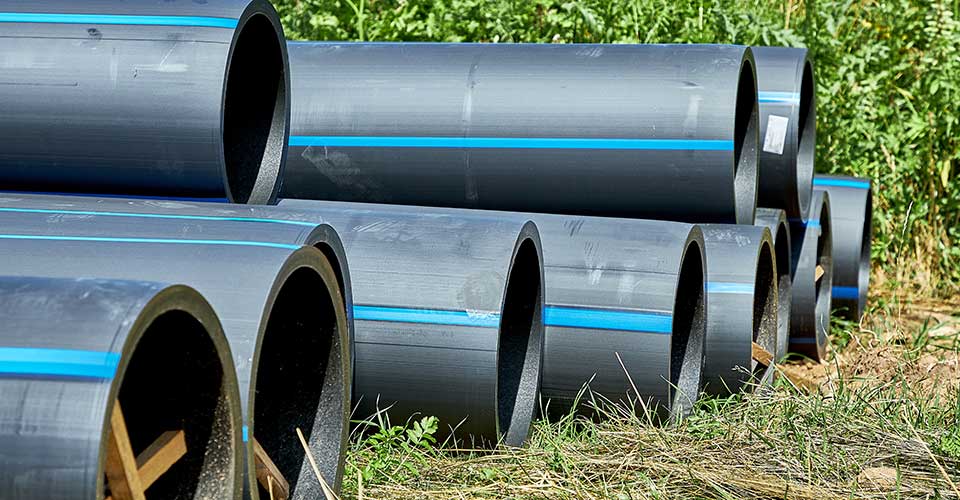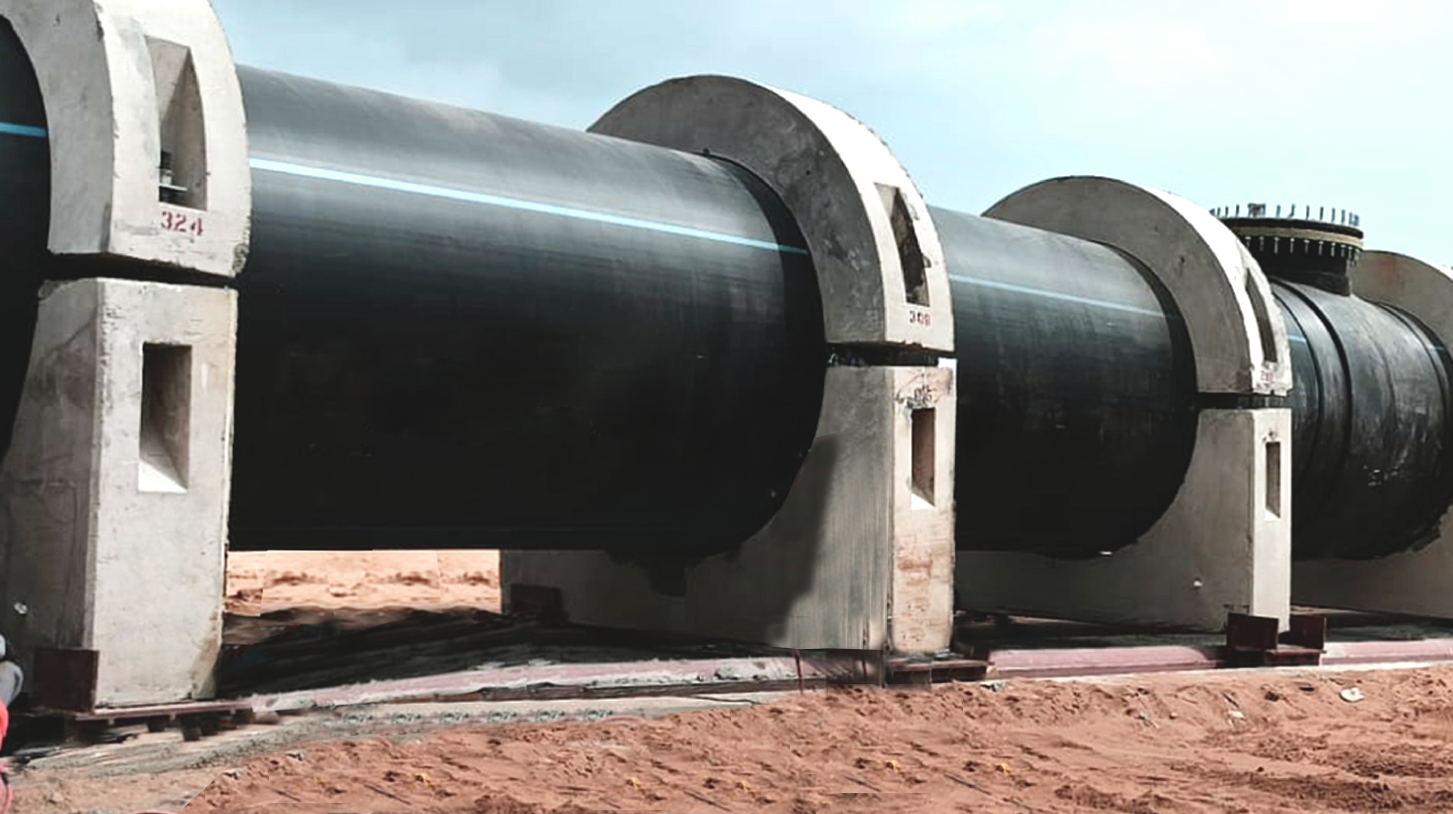Common Questions About Texas hdpe pipe manufacturer and What They Offer
Wiki Article
Explore the Production Process Behind High-Quality HDPE Pipeline and Its Applications
The manufacturing process of high-grade HDPE pipes is detailed and systematic. It starts with the selection of basic materials that enhance efficiency. Following this, ethylene undertakes polymerization to create material, which is after that shaped via extrusion. Quality control is critical, making certain that the end product satisfies rigid criteria. The journey of HDPE pipes does not finish with manufacturing. Their applications across numerous industries reveal a broader significance worth checking out.Recognizing HDPE: Qualities and Advantages

High-density polyethylene (HDPE) is a flexible thermoplastic recognized for its resilience and resistance to various environmental aspects. This material shows excellent tensile stamina, making it suitable for requiring applications. Its low-density framework adds to a lightweight item, helping with simplicity of dealing with and setup. HDPE also showcases exceptional resistance to chemicals, which lessens destruction when subjected to rough substances.
The material's reduced dampness absorption further improves its long life, making it optimal for usage in pipelines and storage space containers. Additionally, HDPE is resistant to ultraviolet (UV) radiation, ensuring that products maintain their stability even when subjected to sunshine. Additionally, its flexibility permits the production of detailed shapes without jeopardizing strength. The environment-friendly nature of HDPE, typically originated from recycled materials, includes in its charm, advertising sustainable techniques in manufacturing. In general, these buildings and advantages make HDPE a favored choice for different industrial and consumer applications.
Raw Material Choice for HDPE Production
The selection of resources for HDPE manufacturing is necessary to confirm the end product meets the desired specs and high quality criteria. High-density polyethylene (HDPE) is mainly produced from polymerized ethylene, stemmed from fossil fuels such as gas or crude oil. The high quality of these feedstocks significantly affects the mechanical and thermal buildings of the last HDPE.Ingredients additionally play a considerable role in enhancing HDPE's efficiency, consisting of antioxidants, UV stabilizers, and colorants, which boost sturdiness and resistance to environmental elements. The choice procedure have to consider not only the chemical structure of the raw materials but additionally their handling qualities to assure reliable manufacturing.
Furthermore, the sourcing of raw products need to prioritize sustainability and conformity with ecological laws, as accountable methods are vital in today's market. Ultimately, cautious raw material selection lays the structure for producing premium HDPE pipelines appropriate for diverse applications.
The Extrusion Refine: Shaping HDPE Pipe
The extrusion process plays an important role in forming HDPE pipes, starting with precise material preparation methods that guarantee excellent circulation and uniformity. Just as important is the design of the die, which straight affects the final measurements and surface top quality of the pipeline. With each other, these aspects add greatly to the effectiveness and quality of HDPE pipe production.Material Preparation Strategies
Efficient production of HDPE pipes begins with meticulous material preparation strategies, especially the extrusion process. Throughout this phase, high-density polyethylene material is initial dried to eliminate wetness, making certain ideal circulation qualities. The resin is after that fed right into the extruder, where it goes through heating and melting, changing into a viscous state. This home heating process is thoroughly controlled to maintain the material's stability and performance. The liquified HDPE is forced via a die, forming it into a continual pipeline kind. Proper temperature level administration throughout extrusion is important, as it directly affects the product's residential or commercial properties and the end product quality. Once shaped, the HDPE pipe is cooled down and cut to defined lengths, prepared for subsequent handling and applications.Die Layout Significance
Accuracy in die layout plays an essential duty in the extrusion procedure of HDPE pipes. The die offers as the final shaping tool, straight influencing the pipeline's dimensions, wall surface density, and surface coating. A well-designed die guarantees uniform product flow, reducing flaws such as irregularities and weak spots. The geometry of the die must be maximized to accommodate the particular residential or commercial properties of HDPE, including its thickness and thermal habits throughout extrusion. Furthermore, the cooling price of the product as it goes through the die can noticeably affect the pipe's structural integrity. As a result, buying innovative die technology is important for suppliers intending to create high-grade HDPE pipelines that meet market requirements and consumer expectations.Quality Assurance Measures in HDPE Production
Numerous variables influence the top quality of HDPE pipeline production, effective quality control measures are important to assure consistency and dependability in the last item (American Plastics HDPE Pipe Manufacturing). Trick top quality control methods include extensive product examination, confirming that the raw polyethylene fulfills established standards for pureness and thickness. Throughout the extrusion procedure, parameters such as temperature, pressure, and cooling time are carefully checked to preserve dimensional accuracy and architectural integrityIn enhancement, post-production screening is necessary; suppliers frequently carry out hydrostatic examinations to examine the pipe's stamina and resistance to pressure. Visual inspections for surface issues even more boost quality control. Qualification from relevant requirements organizations, like ASTM or ISO, gives an extra layer of trustworthiness. By applying these detailed quality assurance measures, producers can reduce defects, boost performance, and make sure that the HDPE pipelines fulfill the specific needs of different applications, eventually resulting in client contentment and count on the product.
Applications of HDPE Pipe Across Industries
HDPE pipes are made use of throughout various sectors due to their sturdiness and versatility. In water circulation systems, they guarantee reliable delivery, while in wastewater administration, they provide dependable services for waste transport. Furthermore, click here for more agricultural irrigation networks profit from HDPE's resistance to rust and flexibility, making it a perfect selection for modern-day farming techniques.
Water Distribution Equipments
A considerable number of industries count on high-density polyethylene (HDPE) pipes for efficient Get More Information water circulation systems. Understood for their resilience and resistance to rust, HDPE pipes are widely used in local water system networks, farming watering, and commercial applications. Their lightweight nature helps with very easy handling and setup, decreasing labor prices and time. In addition, HDPE pipes can fit different pressure levels, making them appropriate for both reduced and high-pressure systems. Pipe Manufacturing Midland TX. The versatility of the material permits for seamless assimilation into existing framework, minimizing the need for substantial excavation. Moreover, HDPE's resistance to chemical leaching guarantees that the water delivered continues to be safe and tidy, making it a perfect choice for preserving the high quality of drinkable water throughout different sectorsWastewater Management Solutions
Effective water circulation systems also lead the way for cutting-edge wastewater monitoring remedies, where high-density polyethylene (HDPE) pipes play a significant function. Popular for their sturdiness and resistance to deterioration, HDPE pipelines are perfect for carrying wastewater in different settings. Their adaptability enables simple setup in complex settings, reducing the need for comprehensive excavation. Additionally, HDPE's smooth interior surface minimizes rubbing, boosting flow rates and effectiveness. These pipelines are also resistant to chemical leaching, guaranteeing that pollutants do not endanger the surrounding setting. Industries, municipalities, and therapy facilities progressively depend on HDPE pipelines for their integrity and durability, making them a recommended selection for modern wastewater administration systems. This versatility emphasizes the essential significance of HDPE pipes throughout various applications.Agricultural Irrigation Networks
Agricultural irrigation networks profit greatly from the usage of high-density polyethylene (HDPE) pipelines, which supply reliable and reputable water shipment to crops. HDPE pipelines are lightweight, making them very easy to transfer and mount, while their versatility enables numerous configurations in diverse surfaces. These pipelines demonstrate outstanding resistance to deterioration, chemicals, and UV radiation, making certain durability in harsh agricultural environments. In addition, their smooth indoor surface decreases friction loss, enhancing water circulation and reducing power expenses associated with pumping. The longevity of HDPE pipelines, commonly exceeding 50 years, adds to lower maintenance and substitute expenses. Farmers significantly rely on HDPE pipelines to enhance irrigation effectiveness and promote sustainable agricultural methods, ultimately leading to enhanced plant returns and source preservation.
Future Fads in HDPE Pipeline Innovation
As the need for lasting and reliable facilities grows, developments in HDPE pipe innovation are positioned to transform numerous industries. Arising trends consist of the combination of clever modern technologies, such as sensors and IoT capacities, which promote real-time tracking of pipeline problems, decreasing maintenance prices and avoiding leaks. In addition, the development of innovative manufacturing strategies, such as 3D printing, is making it possible for the manufacturing of facility, customized pipe styles that deal with certain project requirements.The emphasis on recycling and circular economic situation techniques is driving the innovation of HDPE pipes made from recycled materials, enhancing sustainability. Enhanced jointing methods, such as electro-fusion and mechanical fittings, are also improving setup performance and integrity. The expanding emphasis on environmental guidelines is pressing producers to embrace greener manufacturing procedures, making certain that HDPE pipelines not just satisfy industry criteria yet additionally cultivate a more lasting future for facilities growth.
Often Asked Questions
How Does HDPE Compare to Various Other Plastic Products?
HDPE surpasses lots of various other plastic materials relating to durability, chemical resistance, and versatility. Its reduced density and high tensile toughness make it see this here suitable for various applications, usually surpassing choices in both efficiency and long life.What Are the Environmental Impacts of HDPE Manufacturing?
The ecological effects of HDPE production consist of greenhouse gas exhausts, power intake, and prospective pollution from manufacturing procedures. Furthermore, incorrect disposal can bring about dirt and water contamination, raising issues regarding lasting ecological results.Can HDPE Water Lines Be Reused?
Yes, HDPE pipes can be recycled. Many centers accept used HDPE for processing, changing it into brand-new products. This recycling adds to sustainability efforts, decreasing plastic waste while preserving sources and energy in the manufacturing cycle.What Is the Life-span of HDPE Pipeline?

Exactly How Do Temperature Level Variants Impact HDPE Pipe Performance?
Temperature variants significantly affect HDPE pipeline performance, affecting adaptability and stamina. High temperature levels can cause softening, while reduced temperatures may cause brittleness, inevitably influencing the pipeline's longevity and viability for different applications in varied environments.Report this wiki page